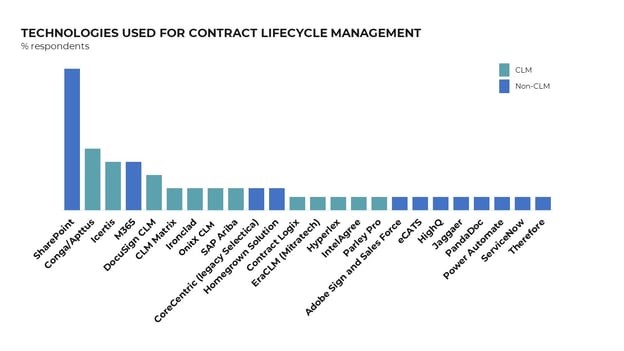

Advice

Contract Management: Still A Hot (And Fraught) Technology Market
- Contracts Solutions
- 3 Mins
We hear the buzz at conferences, read about the money pouring into the burgeoning contract management technology sector, receive solicitations from a bewildering assortment of vendors, and talk with colleagues who mention unfamiliar brands. Moreover, it’s hard to keep track of solution names as larger companies scoop up newer entrants or long-standing companies merge and rebrand.
Hyperion Research benchmarking data shows that nearly half of legal departments plan to invest in contract lifecycle management (CLM) solutions in the next 12-18 months - one quarter making first-time investments in CLM and one quarter additional investments. Roughly half are planning investments in AI-driven contract analytics (CA) solutions.

There is both push and pull at play in this hot market. Much has already been said about the pandemic-driven acceleration in legal tech adoption. With workforces suddenly scattered, the legal department leaders who had been advocating for and implementing tech-enabled, standardised processes had proof of the benefits, most notably in e-signature. The pandemic also validated the need for AI to understand exactly what lay in contracts, starkly demonstrated as legal departments scrambled to investigate force majeure provisions. Economic headwinds notwithstanding, for some it may now prove easier to get funding - and it’s certainly high time to drive adoption.
But there is more to the hot contracting technology market than a push for efficiency and control. The “pull” aspect of the growth dynamic – successful sales efforts by legal technology vendors – stems from their ability to dazzle potential buyers with workflow automation and burgeoning AI-based capabilities that enable legal departments to better manage obligations, compliance, and risk.
Market dynamics demonstrated through Hyperion Research and our advisory practice offer advice for those embarking on contracting transformation projects. What follows here is an orientation to the market that buyers of contract management technology are wading into. Making the case for investment, and engaging cross-functional stakeholders is a structured governance process to advance in contracting maturity.
Contracting Technology Is Immature and Fragmented
Vendors Jockeying for Position
We see a proliferation of contract solution technologies and a highly fragmented market. Vendors are approaching contracting transformation from different angles: as contract lifecycle management solutions, which may or may not be AI-enabled, and through contract analytics solutions, which may focus on pre-signature and/or post-signature data.
There are many tech solutions being marketed as “contract lifecycle management” that have a limited set of features for legal department needs – contributing to a purgatory of workarounds and stop-gaps. And there is a wide spectrum from “CLM-lite” to super-sophisticated solutions that trigger significant financial and operational undertakings.
Legal Departments Making Do
Meanwhile, our survey shows that legal departments are grappling with a hotchpotch of contracting and non-contracting technologies. When we asked about the technologies they used for contract lifecycle management, SharePoint, an enterprise software, was by far the most common choice, selected by almost a third. We were struck by how many respondents named non-legal solutions. They are making do with software lacking the features needed to support core legal work - drafting, assembly and negotiation - as well as to manage playbooks and templates.

Contracting Technology is Not a Silver Bullet
Unfortunately, contracting technology is characterised by low customer satisfaction; only one-third (35%) of Hyperion Research survey respondents said that they are satisfied with their Contract Lifecycle Management (CLM) Solutions and only 15% with their Contract Analytics (CA) solutions.
Buyers of contract management solutions clearly struggle to make the right match, often buying solutions for which their organisations are not ready, making do with sub-optimal solutions, or buying a solution that works well for one function (e.g., procurement) but not so well for another (e.g., sales). We also see a pattern of treating contracting technology as a “silver bullet,” without laying the necessary groundwork for long-term programme success. A sound contracting transformation initiative rests on an honest assessment of the current state (not just tech, but also people, process / policies, and data) and leverages cross-functional teams that set forth the vision, make the business case, define requirements and crucially, drive adoption and continuous improvement. In other words, contracting transformations start by putting in place a management infrastructure that will exist well beyond phase 1 implementation (“go live”).
And in this hype-driven market, that cross-functional team will need to look past AI claims into how the AI meets (or doesn’t) the organization's specific, well-defined needs. Advanced CLM solutions now leverage AI in some form, but there is wide variation in how AI is applied. For example, some solutions solely apply AI to extract key terms and dates from legacy contracts for obligation management. Others incorporate AI-driven contract analytics capabilities throughout the lifecycle, including pre-signature contract review, negotiation support and process analytics, as well as extensive repository extraction, analyses, and data-driven intelligence.

At this point of evolution of contract management solutions, the right question is not "Does it use AI?" but rather, "What exactly does the AI do?” And if it supports any high priority requirements, follow-on questions include: How accurately? With how much effort on the part of users? Are the AI capabilities effectively streamlined in the natural workflows (rather than bolted-on, requiring separate workflows that might be neglected)?
The contents of this article are intended to convey general information only and not to provide legal advice or opinions.